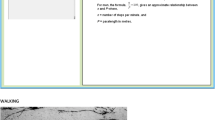Abstract
A comparison of the performance of two groups of third-grade students practicing division problems is used to assess the effect of a commercial computer-assisted instruction (CAI) drill program on learning. The progress of the experimental group, who used the computer drill program, is compared with a similar group of students using a conventional print drill method. The data demonstrate that after five weeks of practice, no significant differences existed in the achievement level of either the experimental group or the control group. The findings further suggest that use of computer drill materials may be no more effective than print drill materials for assisting third-grade students to achieve proficiency level in learning division of whole numbers.
Similar content being viewed by others
References
Asbell, B. (1984, March 26). Writing to read.The Dallas Morning News, pp. C1–3.
Barbato, J. (1984, November 14). Where does the computer stop and the human mind begin?The Chronicle of Higher Education, pp. 5–6.
Bork, A. (1984). Computers in education today- and some possible futures.Phi Delta Kappan, 66, 239–243.
Campbell, D. L., & Campbell, J. H. (1982). Microcomputer mania—avoid the pitfalls.Journal of Business Education, 58, 89–92.
Campbell, D. L., Horn, Charles J., and Leigh, Robert K. (1985, October). Empirical basis of commercially available education software,Sociological Abstracts.
Clark, R. E. (1983). Reconsidering research on learning from media.Review of Educational Research, 53, 445–459.
Clark, R. E. (1984). Clark’s reply.Educational Communication and Technology, 32, 238–241.
Clark, R. E. (1985). Confounding in educational computing research.Journal of Educational Computing Research, 1, 137–148.
Heinich, R. (1984). The proper study of instructional technology.Educational Communication and Technology, 32, 67–87.
Heinich, R. (1985). Instructional technology and the structure of education.Educational Communication and Technology, 33, 9–15.
Kellerman, J. (1984, January). Low-tech: High-fear hucksters push kid computers.Other Views, 13A.
Kerr, S. T. (1985). Asking new questions about technology and the social world of education.Educational Communication and Technology, 33, 3–8.
Komoski, P. K. (1984). Educational computing: The burden of insuring quality.Phi Delta Kappan, 66, 244–248.
Kulik, J. A., Bangert, R. L., & Williams, G. W. (1983). Effects of computer-based teaching on secondary school students.Journal of Educational Psychology, 75, 19–26.
Petkovich, M. D. & Tennyson, R. D. (1984). Clark’s learning from media: A critique.Educational Communication and Technology, 32, 233–241.
Petroski, H. (1984, November 14). Technology is an essential component of today’s liberal-arts education.The Chronicle of Higher Education, p. 88.
Pratt, S. (1984). Your child and your apple—think again!In-Cider, 2(5), 8.
Salomon, G., & Gardner, G. (1986). The computer as educator: Lessons from television research.Educational Researcher, 15(1), 13–19.
Turkle, S. (1984).The second self: Computers and the human spirit. New York: Simon and Schuster.
Wagschal, P. (1984). A last chance for computers in the schools?Phi Delta Kappan, 66(4), 251–254.
Author information
Authors and Affiliations
Rights and permissions
About this article
Cite this article
Campbell, D.L., Peck, D.L., Horn, C.J. et al. Comparison of computer-assisted instruction and print drill performance: A research note. ECTJ 35, 95–103 (1987). https://doi.org/10.1007/BF02769435
Issue Date:
DOI: https://doi.org/10.1007/BF02769435




